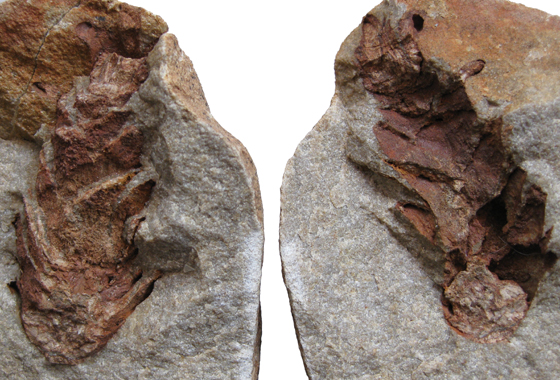


left - cast; right - mold
Molds and casts are three-dimensional impressions in which the surface contours of an organism are preserved. These types of fossils are the most recognizable and very common. Molds and casts that faithfully replicate the external form of an organism provide paleontologists clues about the surface anatomy and behavior of an ancient organism
Molds: Mold fossils come from a process called authigenic preservation; a process which leaves a negative impression, or indent, of an organism in the rock after the organism itself has deteriorated. Sand or mud covers the deceased organism and, over time, that sand or mud hardens into rock, encasing the organism. The organism continues to decay, eventually leaving only an imprint. Unlike cast fossils, mold fossils are hollow. Entire organisms, partial organisms, or even traces of the passing of organisms can leave mold fossils. Due to the way this type of fossil is formed, the resulting image is a negative image of the part of the organism’s body that made the impression. In other words, it is backward. Common mold fossils include skin, leaves, teeth, claws, and embryos.
Casts: Cast fossils are like mold fossils in that they formed, at least in part, with an imprint made in a rock or sediment. However, cast fossils go one step further. Water seeps through the rock surrounding the mold fossil, leaving behind minerals which fill the mold. The minerals harden, taking the shape, or the natural cast, of the mold fossil. In other words, mold fossils take up negative space and cast fossils take up positive space. Cast fossils also include skin, leaves, teeth, and embryos.
 An animal dies, its skeleton settles on the sea floor and is buried by sediment.
An animal dies, its skeleton settles on the sea floor and is buried by sediment.
An animal dies and its body sinks to the sea floor. The soft parts of the animal rot away, leaving only its skeleton. The skeleton is buried by sediment (like mud or sand) falling from the ocean above. The sea floor is an ideal place for fossilisation, which explains why many fossils are marine (from animals that lived in the sea). Land animals may die and be swept out to sea to be buried in the same way.
 The sediment surrounding the skeleton thickens and begins to turn to stone.
The sediment surrounding the skeleton thickens and begins to turn to stone.
The skeleton continues to be buried as sediment is added to the surface of the sea floor. As the sea floor sinks, pressure increases in the lower layers of sediment and it turns it into hard rock.
 The skeleton dissolves and a mould is formed.
The skeleton dissolves and a mould is formed.
Now buried at depth and surrounded by stone, the skeleton is dissolved by ground water. This leaves a cavity (or hole) preserving the shape of the original skeleton. This cavity is known as a natural mould.
 Minerals crystallise inside the mould and a cast is formed.
Minerals crystallise inside the mould and a cast is formed.
Water rich in minerals enters the mould, and fills the cavity. The minerals deposited in the mould form a cast of the mould. This cast has the same shape as the original skeleton, but none of its internal features.
 The fossil is exposed on the Earth's surface.
The fossil is exposed on the Earth's surface.
Millions of years later, the rock surrounding the skeleton rises to the Earth's surface (this happens during mountain building, earthquakes and other earth processes). The rock is worn away by wind and rain, and the fossil is now exposed, waiting to be found!

Mold and cast of a Trilobite, Ordocician - Herault, France.
Mold and cast of a Trilobite, Ordocician. Photograph. Britannica ImageQuest, Encyclopædia Britannica, 25 May 2016.
quest.eb.com/search/132_1347652/1/132_1347652/cite. Accessed 8 Dec 2020.

Psittacosaurus - Cast of Psittacosaurus, a ceratopsian dinosaur found in China
Psittacosaurus. Photography. Britannica ImageQuest, Encyclopædia Britannica, 25 May 2016.
quest.eb.com/search/139_1993072/1/139_1993072/cite. Accessed 8 Dec 2020.

Fossil Snail molds (Turritella), Eocene
Fossil Snail molds (Turritella), Eocene. Photograph. Britannica ImageQuest, Encyclopædia Britannica, 25 May 2016.
quest.eb.com/search/132_1343128/1/132_1343128/cite. Accessed 8 Dec 2020.

Cast and Mold of Fossil Leaf- from the Eocene Epoch Green River Formation in Colorado.
Cast and Mold of Fossil Leaf. Photography. Britannica ImageQuest, Encyclopædia Britannica, 25 May 2016.
quest.eb.com/search/139_1930896/1/139_1930896/cite. Accessed 8 Dec 2020.

An internal fossil cast of trilobite - from the Ordovician period (500 to 435 million years ago), found in the Lower Llanvirn sediments, Builth Wells inlier, Powys, Wales.
An internal fossil cast of trilobite. Photography. Britannica ImageQuest, Encyclopædia Britannica, 25 May 2016.
quest.eb.com/search/132_1231077/1/132_1231077/cite. Accessed 8 Dec 2020.

Creodont fossil - Cast of a fossil mammal of the extinct order Creodonta that lived during the Eocene in the Wyoming area 52 million years ago.
Creodont fossil. Photography. Britannica ImageQuest, Encyclopædia Britannica, 25 May 2016.
quest.eb.com/search/139_2015397/1/139_2015397/cite. Accessed 8 Dec 2020.

Mesosaurus tenuidens fossil - Anterior portion of skeleton of extinct reptile, Mesosaurus tenuidens gervais from the Karoo Formation, Griqualand West, South Africa. Cast of the type specimen.
Mesosaurus tenuidens fossil. Photograph. Britannica ImageQuest, Encyclopædia Britannica, 31 Aug 2017.
quest.eb.com/search/132_1493835/1/132_1493835/cite. Accessed 8 Dec 2020.

Burgess Shale brachiopods, A group of fossil brachiopods from the Middle Cambrian, Burgess Shale, British Columbia
Burgess Shale brachiopods. Photography. Britannica ImageQuest, Encyclopædia Britannica, 25 May 2016.
quest.eb.com/search/119_1802568/1/119_1802568/cite. Accessed 29 Sep 2021.